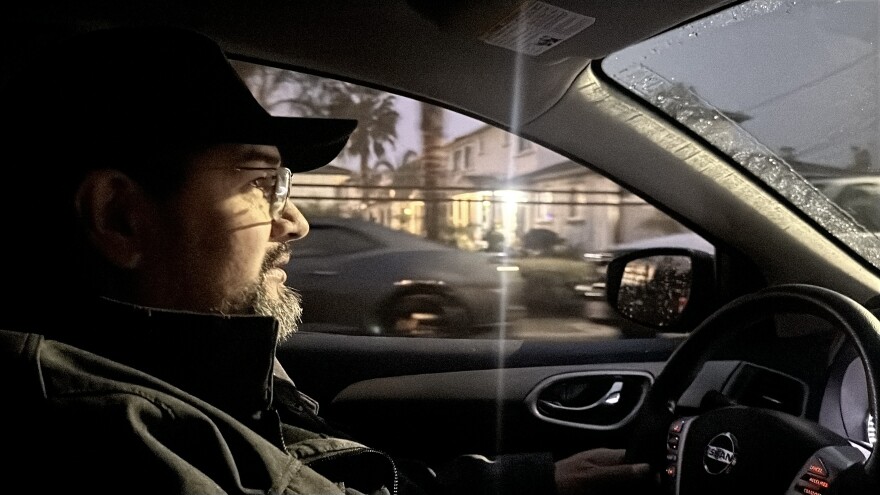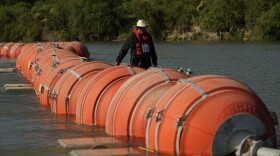Have a tip? 📨
The Investigations Team at KPBS holds powerful people and institutions accountable. But we can’t do it alone — we depend on tips from the public to point us in the right direction. There are two ways to contact the I-Team.
For general tips, you can send an email to investigations@kpbs.org.
If you need more security, you can send anonymous tips or share documents via our secure Signal account at 619-594-8177.
To learn more about how we use Signal and other privacy protections, click here.
In the predawn hours on a recent rainy Friday, the small unit fills up on coffee as they prepare for their mission: patrol San Diego’s Linda Vista neighborhood in search of suspicious vehicles.
They’re not cops or private investigators. They’re activists with Union del Barrio, a locally based immigrant rights group, looking for any signs that U.S. Immigration and Customs Enforcement (ICE) is trying to arrest their neighbors.
These volunteers are trained to spot undercover vehicles. Usually American-made SUVs like Dodge Caravans or Ford Explorers with tinted windows that don’t normally park in their neighborhoods.
Once they verify that a vehicle belongs to ICE, the activists notify hundreds of followers via social media and group chats.
That is how some immigrant rights activists in San Diego are responding to President Donald Trump’s plans to launch “the largest deportation operation in American history.”
“The goal is always to prevent families from being separated,” said Benjamin Prado, an activist with Union del Barrio. “We’ve had too much family separation throughout the years.”
Union del Barrio conducted similar patrols during the first Trump term.
The patrols in neighborhoods with high numbers of immigrants are part of a larger array of actions. Others include: know-your-rights workshops; food and clothing drives; temporary housing for migrants and asylum seekers; and free legal representation to people facing deportation.
“I think the patrols really fit well with the efforts of all the advocates doing work on the ground,” said Ian Seruelo, chair of the San Diego Immigrant Rights Consortium, which is a coalition of more than 50 civil and immigrant rights organizations in the region.
Trump’s calls for mass deportations evoked images of daily raids with hundreds of people being dragged out of their workplaces and being sent to detention centers.
Days after Trump’s inauguration, ICE made a big show of publicizing arrests. In just one day, ICE agents rounded up 1,200 people in Chicago.
Administration officials said these raids are for our public safety — they are going after immigrants without legal status who have criminal convictions. But a review of Chicago arrests revealed that nearly half of the people detained were nonviolent offenders or people who had never been convicted of a crime.
But in San Diego, apart from a few targeted arrests of individuals in North County, activists so far haven’t seen that level of enforcement.
ICE does not break down its arrest numbers by counties or cities on its website, and the agency would not provide KPBS with San Diego County numbers.
But even though ICE raids have not materialized in San Diego County, there is still a high level of fear and resentment among large immigrant populations.

‘People are angry’
San Diego’s immigrant communities, including those with and without legal status, are furious at being branded criminals, Prado said.
“People are angry,” he said. “Any human being would be when you have your family being criminalized.”
Prado drove one of three vehicles that patrolled the streets of Linda Vista on the recent Friday. He drove by parks, strip malls, and apartment complexes that are home to working class immigrant families. Some of them are too afraid to leave their homes, he said.
That fear prevents some people from leaving their homes, going to work or school. But it doesn’t stop them from finding ways to make their voices heard.
Since the inauguration, hundreds of San Diegans have participated in protests against the Trump administration’s immigration policies and rhetoric.
The demonstrations, which have taken place in San Ysidro, National City, San Diego and Oceanside, have been peaceful. With people carrying signs that read, “Stop the Raids, Stop the Hate,” and “Immigrants Make America Great.”
During the community patrol in Linda Vista, Pardo drove by a metal utility box with the words, “F*** ICE” spray painted on it.
“The sentiment of the community is very clear,” Prado said.
Previous patrols in Escondido and Vista have spotted ICE arrests in those areas. However, Friday’s patrol in Linda Vista was uneventful.
Still, activists said there’s value in them being out in the community. “It really helps support the community,” said Adrianna Jasso, an advocate with Union del Barrio.
An added benefit of the patrols, Seruelo said, is that they help give people a sense of agency.
“They have knowledge, they have the contacts, they have the network,” he said. “They feel empowered and that’s exactly what we want to happen. We don’t want our community members to just end up in fear and staying home.”
ICE did not respond to questions from KPBS about community patrols.
Members of the Trump administration have publicly criticized certain forms of activism that they believe prevent ICE from detaining individuals.
Last month, Border Czar Tom Homan told CNN that sanctuary cities are making it difficult to arrest immigrants without legal status.
“They call it 'know your rights,'” he said. “I call it 'how to escape arrest.'”
Combating misinformation
The patrols also help combat misinformation that can spread throughout the community.
“There’s a gap between the official narrative and what is happening on the ground,” Jasso said.
That fear is partly fueled by false alarms of ICE raids, mostly on social media. In January, a photo of three Border Patrol vehicles parked outside of Rady Children’s Hospital sparked rumors of immigration raids in the region.
The caption of the photo, posted on social media, read, “BORDER PATROL AT RADY CHILDRENS HOSPITAL BY THE ENTRANCE. CONFIRMED.”
But there were no raids. Or even individual arrests. It is common for Border Patrol agents to drive injured migrants to local hospitals. In some cases, agents will stay in the hospital until injured migrants are dispatched, according to a statement released by the hospital.
“Part of what has created a lot of fear and anxiety is the role of social media,” Jasso said.
The patrol volunteers are trained to verify — get at least two sets of eyes on an ICE agent — before ever posting anything online or sharing it in their group chats.
Other members of the Immigrant Rights Consortium have begun adding social media literacy and misinformation to their know-your-rights presentations, Seruelo said.
“We want to make sure that it’s coming from a trusted source, that those sources are verified,” he said.
- Immigration lawyers worried legal asylum seekers will self-deport after Trump administration email
- International students in San Diego caught up in ‘mass revocation of student visas'
- San Diego Zoo workers push for higher wages as executive pay skyrockets
- El Cajon immigration raid shows stark change in enforcement priorities under President Trump





